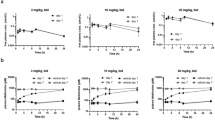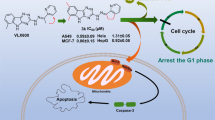Summary
The involvement of flavin-containing monooxygenase (FMO) in the 6-methylhydroxylation of the experimental anti-cancer drug 5,6-dimethylxanthenone-4-acetic acid (DMXAA) was investigated by use of human liver microsomes and microsomes containing cDNA-expressed FMOs. The involvement of FMO in the formation of 6-methyl hydroxylate of DMXAA, 6-hydroxymethyl-5-methylxanthenone-4-acetic acid (6-OH-MXAA) in human liver microsomes was indicated by the fact that this biotransformation was sensitive to heat treatment, increased at pH 8.3, and inhibited by methimazole. Only FMO3 formed 6-OH-MXAA at a similar rate to that in cDNA-expressed cytochromes P-450 (CYP)1A2. The results of this study indicate that human FMO3 has the capacity to form 6-OH-MXAA, but plays a lesser important role for this reaction than CYP1A2 that has been demonstrated to catalyse 6-OH-MXAA formation.
Similar content being viewed by others
Abbreviations
- CYP:
-
cytochrome P-450
- DMXAA:
-
5,6-dimethylxanthenone-4-acetic acid
- FMO:
-
flavin-containing monooxygenase
- HPLC:
-
high performance liquid chromatography
- 6-OH-MXAA:
-
6-hydroxymethyl-5-methylxanthenone-4-acetic acid.
References
Cashman JR (1995) Structural and catalytic properties of the mammalian flavin-containing monooxygenase. Chem Res Toxicol 8: 165–181.
Hines RN, Cashman JR, Philpot RM, Williams DE and Ziegler DM (1994) The mammalian flavin-containing monooxygenases: Molecular characterization and regulation of expression. Toxicol Appl Pharmacol 125: 1–6.
Kestell P, Paxton JW, Rewcastle GW, Dunlop I and Baguley BC (1999) Plasma disposition, metabolism and excretion of the experimental antitumour agent 5,6-dimethylxanthenone-4-acetic acid in the mouse, rat and rabbit. Cancer Chemother Pharmacol 43: 323–330.
Miners JO, Valente L, Lillywhite KJ, Mackenzie PI, Burchell B, Baguley BC and Kestell P (1997) Preclinical prediction of factors influencing the elimination of 5,6-dimethylxanthenone-4acetic acid, a new anticancer drug. Cancer Res 57: 284–289.
Omura T and Sato R (1964) The carbon monoxide binding pigment of liver microsomes. I. Evidence for its hemoprotein nature. J Biol Chem 23: 2370–2378.
Phillips IR, Dolphin CT, Clair P, Hadley MR, Hutt AJ, McCombie RR, Smith RL and Shephard EA (1995) The molecular biology of the flavincontaining monooxygenases of man. Chem-Biol Interact 96: 17–32.
Rewcastle GW, Atwell GI, Li ZA, Baguley BC and Denny WA (1991) Potential antitumour agents. 61. Structure-activity relationships for inn vivo colon 38 activity among disubstituted 9-oxo-9H-xanthenone-4-acetic acids. J Med Chem 34: 217–222.
Rewcastle GW, Kestell P, Baguley BC and Denny WA (1990) Light-induced breakdown of flavone acetic acid and xanthenone analogues in solution. J Natl Cancer Inst 82: 528–529.
Ring BJ, Wrighton SA, Aldridge SL, Hansen K, Haehner B and Shipley LA (1999) Flavin-containing monooxygenase-mediated N-oxidation of the M(1)-muscarinic agonist xanomeline. Drug Metab Dispos 27: 1099–1103.
Robson RA, Mathews AP, Miners JO, McManus ME, Meyer UA, Hall PD, Birkett DJ (1987) Characterisation of theophylline metabolism by human liver microsomes. Br J Clin Pharmacol 24: 293–300.
Smith PK, Krohn RI, Hermanson GT, Mallia AK, Garter FH, Provenzano MD, Fujimoto EK, Goeke NM, Olson BJ and Klenk DC (1985) Measurement of protein using bicinchoninic acid. Anal Biochem 150: 76–85.
Webster LK, Ellis AG, Kestell P and Rewcastle GW (1995) Metabolism and elimination of 5,6-dimethylxanthenone-4-acetic acid in the isolated perfused rat liver. Drug Metab Dispos 23: 363–368.
Zhou SF, Paxton JW, Tingle MD, McCall J and Kestell P (1999) Determination of two major metabolites of the novel anti-tumour agent 5,6-dimethylxanthenone-4-acetic acid in hepatic microsomal incubations by high-performance liquid chromatography with fluorescennce detection. J Chromatogr (B) 734: 129–136.
Zhou SF, Paxton JW, Tingle MD and Kestell P (2000) Identification of the human liver cytochrome P450 isozyme responsible for the 6-methylhydroxylation of the novel anticancer drug 5,6-dimethylxanthenone-4-acetic acid. Drug Metab Dispos 28: 1449–1456.
Author information
Authors and Affiliations
Rights and permissions
About this article
Cite this article
Zhou, S., Kestell, P. & Paxton, J.W. 6-methylhydroxylation of the anti-cancer agent 5,6-dimethylxanthenone-4-acetic acid (DMXAA) by flavin-containing monooxygenase 3. Eur. J. Drug Metab. Pharmacokinet. 27, 179–183 (2002). https://doi.org/10.1007/BF03190455
Received:
Issue Date:
DOI: https://doi.org/10.1007/BF03190455




